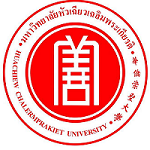Please use this identifier to cite or link to this item:
https://has.hcu.ac.th/jspui/handle/123456789/3981| Title: | Comparative Effects of Brassinosteroid and Brassinosteroid Mimic on Improving Photosynthesis, Lipid Peroxidation, and Rice Seed Set under Heat Stress |
| Authors: | Jutiporn Thussagunpanit Kanapol Jutamanee Lily Kaveeta Witith Chai-arree Porn Pankean Sureeporn Homvisasevongsa Apichart Suksamrarn จุติภรณ์ ทัสสกุลพนิช คณพล จุฑามณี ลิลลี่ กาวีต๊ะ วิทิตร ใจอารีย์ สุรีย์พร หอมวิเศษวงศา อภิชาต สุขสําราญ Kasetsart University. Faculty of Science Kasetsart University. Faculty of Science Kasetsart University. Faculty of Science Kasetsart University, Kamphaengsaen Campus. Faculty of Agriculture at Kamphaengsaen Kasetsart University. Faculty of Science Huachiew Chalermprakiet University. Faculty of Science and Technology Kasetsart University. Faculty of Science |
| Keywords: | Brassinosteroids บราสสิโนสเตียรอยด์ Growth (Plants) การเจริญเติบโตของพืช Photosynthesis การสังเคราะห์แสง Lipid peroxidation ลิพิดเปอร์ออกซิเดชัน Chlorophyll content ปริมาณคลอโรฟิลล์ Chlorophyll คลอโรฟิลล์ Heat stress ความเครียดจากความร้อน |
| Issue Date: | 2015 |
| Citation: | J Plant Growth Regul 34, 320–331 (2015) |
| Abstract: | The application of brassinosteroids (BRs) has been reported to alleviate heat stress. This study investigated the effect of 7,8-dihydro-8α-20-hydroxyecdysone (DHECD)—a BR mimic—by comparison with 24-epibrassinolide (EBR) on the changes in photosynthetic performance, lipid peroxidation, and rice seed set. The results demonstrated that 10−8 M EBR and 10−7 M DHECD had the best actions to counteract the lethal heat temperature of 47 °C for 2 h indicated by a reduction in the number of wilted leaves and an increase in the relative water content and leaf greenness. Moreover, plants treated with EBR or DHECD were exposed to high day/night temperatures of 40/30 °C for 7 days. EBR-treated and DHECD-treated plants showed a high shoot fresh weight, leaf area, chlorophyll content, and carotenoid content. High temperature significantly decreased the leaf net CO2 assimilation rate as well as increased lipid peroxidation. The application of EBR and DHECD maintained the high level of the net CO2 assimilation rate by increasing the stomatal conductance and photochemical quenching. On the other hand, EBR and DHECD decreased the intracellular CO2 content and non-photochemical quenching leading to enhance photosynthesis under heat stress. EBR-treated and DHECD-treated plants significantly reduced their malondialdehyde and hydrogen peroxide contents as well as increasing their total soluble sugar contents. Moreover, BR treatments increased the filled seed of rice. This study confirmed that DHECD—a BR mimic—has activities of heat stress alleviation similar to EBR. |
| Description: | สามารถเข้าถึงบทความฉบับเต็มได้ที่ : https://link.springer.com/article/10.1007/s00344-014-9467-4 |
| URI: | https://has.hcu.ac.th/jspui/handle/123456789/3981 |
| Appears in Collections: | Science and Technology - Articles Journals |
Files in This Item:
| File | Description | Size | Format | |
|---|---|---|---|---|
| Comparative-Effects-of-Brassinosteroid-and-Brassinosteroid-Mimic.pdf | 66.54 kB | Adobe PDF | View/Open |
Items in DSpace are protected by copyright, with all rights reserved, unless otherwise indicated.
